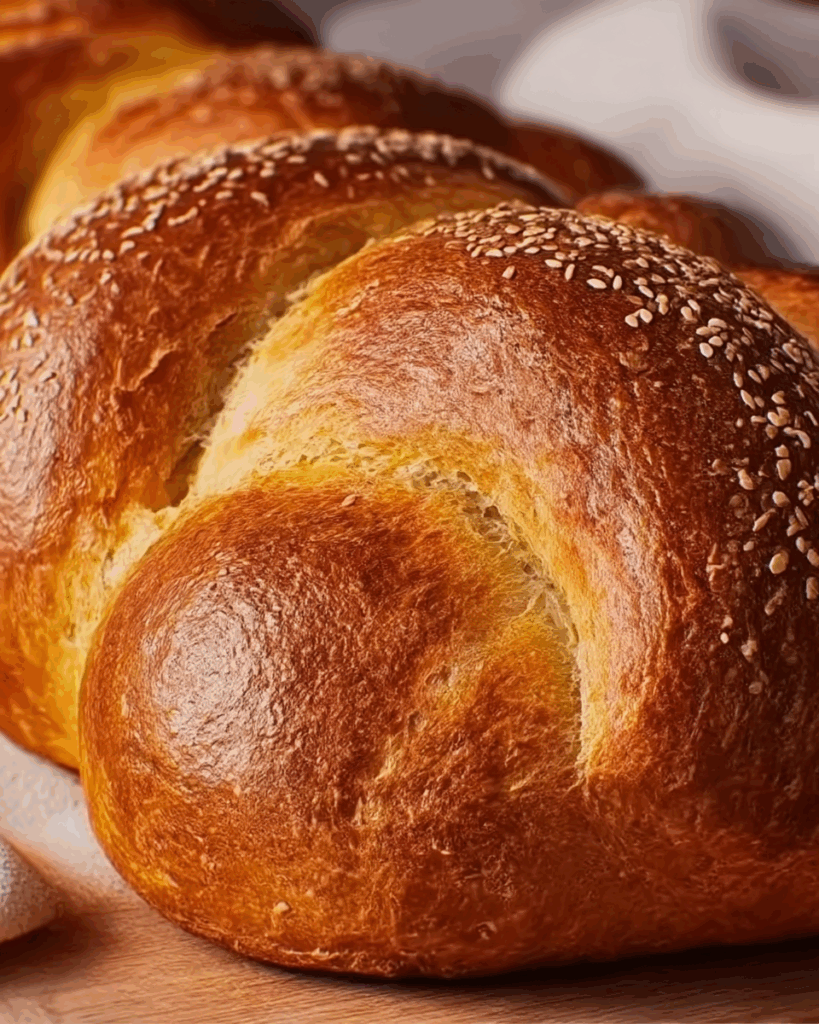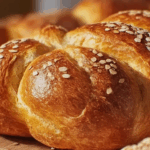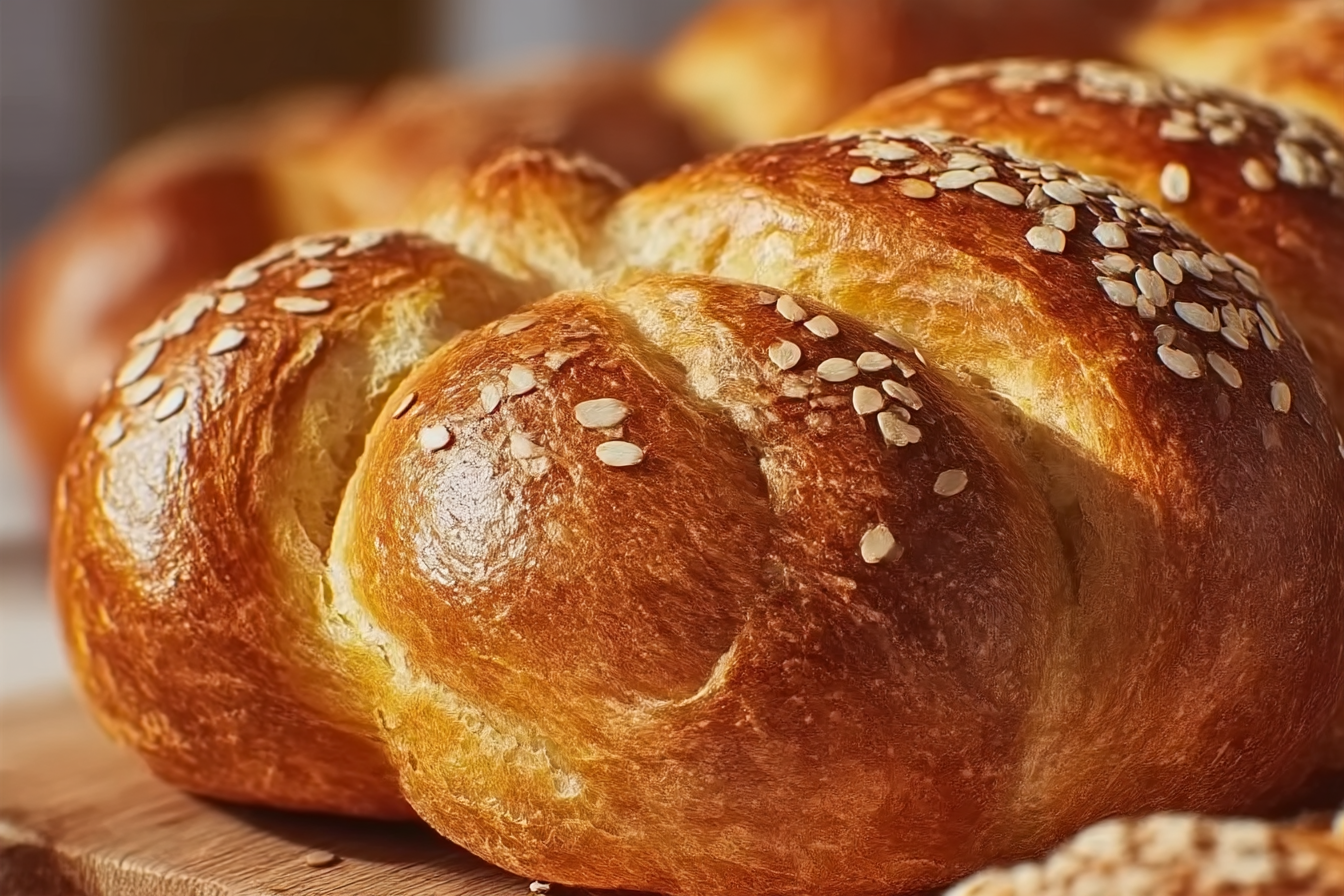Soft, slightly sweet, and golden with a glossy crust, Polish Chałka is the kind of bread that invites you to tear off a warm piece before it even cools. This braided beauty isn’t just about its stunning appearance — it’s about comfort, tradition, and the irresistible aroma that fills your kitchen as it bakes. Whether you’re slathering it with butter and jam or simply enjoying it fresh from the oven, Chałka has a way of making any moment feel special.
Behind the Recipe
My first encounter with Chałka was in my grandmother’s kitchen, where Friday afternoons meant flour-dusted countertops and the rhythmic braiding of dough. She’d hum a familiar tune, her hands expertly folding and weaving the strands. The finished loaf always looked too beautiful to eat — until that first slice vanished in seconds. This recipe brings back those memories, honoring the softness of her touch and the warmth that came with every bite.
Recipe Origin or Trivia
Chałka (pronounced “HOW-kah”) is a traditional Polish yeast bread that closely resembles Jewish challah, though slightly sweeter and often sprinkled with streusel or poppy seeds. Baked for Shabbat, holidays, or simply weekend breakfasts, it has deep roots in Eastern European cuisine. Over time, Chałka became a symbol of comfort — served warm with butter, toasted for breakfast, or even used in decadent French toast. Its signature braid isn’t just for looks, it represents unity and tradition passed from generation to generation.
Why You’ll Love Polish Chałka
Whether it’s your first time baking bread or your hundredth, this one’s a total game-changer.
Versatile: Enjoy it plain, with spreads, or as the base for French toast and bread pudding.
Budget-Friendly: Uses simple, everyday ingredients found in most kitchens.
Quick and Easy: While it requires rising time, the hands-on work is minimal and meditative.
Customizable: Add raisins, streusel topping, or swap in whole wheat flour for variety.
Crowd-Pleasing: The braided loaf is not just beautiful — it disappears fast at gatherings.
Make-Ahead Friendly: The dough can be prepared the day before and refrigerated.
Great for Leftovers: Turns stale slices into dreamy French toast or pudding.
Chef’s Pro Tips for Perfect Results
There’s a little magic in every loaf of Chałka — and these tips help bring it out beautifully.
- Use lukewarm milk and water to activate the yeast properly without killing it.
- Let the dough rise fully for a soft, airy interior. Don’t rush it.
- Oil your hands before braiding to prevent sticking and keep the strands smooth.
- Brush with egg wash twice for that signature shiny golden crust.
- Don’t over-flour the dough — it should be soft and slightly tacky for the best texture.
Kitchen Tools You’ll Need
Simple tools, timeless results. You don’t need much to bake this beauty.
Mixing Bowls: For combining and kneading your dough.
Measuring Cups and Spoons: Precision matters for baking success.
Whisk or Wooden Spoon: To blend ingredients before kneading.
Dough Scraper (optional): Helps shape and transfer sticky dough.
Baking Sheet: A flat surface for perfect browning and baking.
Parchment Paper: Keeps the bottom from sticking and aids cleanup.
Pastry Brush: Essential for a smooth, even egg wash.

Ingredients in Polish Chałka
This bread’s magic lies in its gentle sweetness and pillowy texture — here’s what brings it all together.
- All-Purpose Flour: 4 cups – provides the body and soft crumb of the loaf.
- Instant Yeast: 2 1/4 teaspoons – makes the dough rise with a light, fluffy texture.
- Warm Milk: 1 cup – adds moisture and subtle richness.
- Granulated Sugar: 1/4 cup – gives a gentle sweetness to the dough.
- Butter (softened): 1/4 cup – enriches the dough and adds tenderness.
- Eggs: 2 large – add structure and richness.
- Salt: 1 teaspoon – balances the flavor and enhances overall taste.
- Warm Water: 1/4 cup – helps dissolve yeast and hydrate flour.
- Egg Yolk (for egg wash): 1 – brushed on top for a glossy, golden crust.
- Poppy Seeds or Streusel (optional): for topping – adds visual and textural contrast.
Ingredient Substitutions
Want to make this loaf your own? Try these easy swaps.
Butter: Use margarine or neutral oil for a dairy-free option.
Milk: Almond or oat milk works well in a pinch.
Sugar: Honey or maple syrup for a slightly deeper flavor.
Poppy Seeds: Swap with sesame seeds or omit entirely.
All-Purpose Flour: Use a mix of whole wheat and white for a heartier texture.
Ingredient Spotlight
Yeast: The powerhouse behind that lovely rise — yeast feeds on sugar and creates bubbles that make the dough expand, creating that light, airy structure.
Eggs: Beyond richness, eggs help bind the dough and give the crust its signature shine when used in an egg wash.
Instructions for Making Polish Chałka
Let’s bring this traditional braided bread to life — warm hands, soft dough, and a little patience are all you need.
-
Preheat Your Equipment:
No need to preheat the oven yet, but prep a clean workspace and line a baking sheet with parchment. -
Combine Ingredients:
In a large bowl, mix warm water, yeast, and sugar. Let sit until foamy, about 5–10 minutes. Add warm milk, eggs, softened butter, and salt. Stir in flour one cup at a time until a soft dough forms. -
Prepare Your Cooking Vessel:
Transfer dough to a floured surface and knead for 8–10 minutes until smooth and elastic. Place in a greased bowl, cover, and let rise in a warm place for 1–1.5 hours or until doubled in size. -
Assemble the Dish:
Punch down the dough and divide into three or four equal parts. Roll each into ropes. Braid loosely, then transfer to a parchment-lined baking sheet. Cover and let rise another 30–45 minutes. -
Cook to Perfection:
Preheat oven to 350°F (175°C). Brush the loaf with beaten egg yolk and sprinkle with poppy seeds or streusel if using. -
Finishing Touches:
Bake for 30–35 minutes until golden brown and hollow-sounding when tapped on the bottom. Cool on a wire rack before slicing. -
Serve and Enjoy:
Serve slightly warm with butter and jam, or use slices for French toast the next day. Let the loaf shine as the centerpiece of your breakfast or brunch table.
Texture & Flavor Secrets
The crust is gently crisp, thanks to the egg wash, while the inside is tender and feathery with just a hint of sweetness. The buttery richness lingers after each bite, and the braided form ensures an even bake and beautiful pull-apart sections. It’s soft enough for a breakfast loaf yet rich enough to feel like a treat.
Cooking Tips & Tricks
Bake it like a pro with these helpful hints:
- Let the dough rise in a slightly warm oven (turned off) for faster proofing.
- If dough feels sticky, oil your hands instead of adding more flour.
- Make mini Chałka loaves for gifts or individual servings.
What to Avoid
Avoid these common pitfalls to ensure your loaf turns out perfectly:
- Adding hot liquid — it will kill the yeast. Stick to lukewarm.
- Overproofing — if the dough rises too long, it may collapse in the oven.
- Underbaking — always check the bottom for doneness.
Nutrition Facts
Servings: 10–12
Calories per serving: 210
Note: These are approximate values.
Preparation Time
Prep Time: 25 minutes
Cook Time: 35 minutes
Total Time: 2 hours 30 minutes (including rise time)
Make-Ahead and Storage Tips
Chałka dough can be made ahead and refrigerated overnight. Let it come to room temperature before shaping. Baked loaves store well in an airtight container at room temperature for 2 days or up to 5 in the fridge. Freeze whole or in slices, and reheat gently in the oven or toaster.
How to Serve Polish Chałka
Serve warm with butter, jam, or honey for breakfast. It also pairs beautifully with soft cheeses and fresh fruit. For a savory twist, try toasting it and topping with avocado or herbed cream cheese. It’s also the ultimate base for Sunday French toast.
Creative Leftover Transformations
Give your leftover Chałka a second life with these ideas:
- Classic French toast or baked French toast casserole.
- Bread pudding with cinnamon and raisins.
- Croutons for soups or sweet salads.
- Chałka sandwiches with nut butter and banana.
Additional Tips
- Add a bit of orange or lemon zest to the dough for a citrus twist.
- For a festive look, sprinkle with coarse sugar before baking.
- Let the loaf cool completely before slicing for cleaner cuts.
Make It a Showstopper
Braiding is your secret weapon — try a four-strand braid for an intricate look. Once baked, a light dusting of powdered sugar or a drizzle of honey glaze will give it bakery-level shine. Serve on a wooden board with butter curls and berries for that perfect rustic spread.
Variations to Try
- Raisin Chałka: Add 1/2 cup golden raisins to the dough.
- Nutty Delight: Swirl in chopped walnuts or almonds.
- Cinnamon Swirl: Spread with cinnamon sugar before braiding.
- Whole Wheat Twist: Replace half the flour with whole wheat for a nutty depth.
- Mini Rolls: Divide dough into small rolls and bake individually.
FAQ’s
Q1: Can I use a stand mixer?
Yes, knead on medium speed for about 6–8 minutes.
Q2: How do I store leftovers?
Wrap in foil or plastic wrap and store at room temperature or freeze.
Q3: Can I double the recipe?
Absolutely — just be sure your oven can handle two loaves at once.
Q4: What if I don’t have poppy seeds?
Use sesame seeds, coarse sugar, or leave plain.
Q5: Can I make the dough the night before?
Yes, refrigerate overnight and bring to room temp before shaping.
Q6: Why is my dough not rising?
Check that your yeast is fresh and that liquids weren’t too hot.
Q7: Can I add flavorings?
Yes! Zest, extracts, or spices can be added for variety.
Q8: What makes Chałka different from challah?
Chałka is often sweeter and includes dairy, unlike traditional challah.
Q9: Can I make it vegan?
Use plant milk, vegan butter, and flax eggs for a vegan version.
Q10: Do I need to knead by hand?
Hand-kneading is traditional, but a mixer works just as well.
Conclusion
Polish Chałka isn’t just a loaf — it’s a story braided into every strand. With its pillowy texture, gentle sweetness, and beautifully golden crust, it’s a bread that brings people together. Whether you’re passing down a tradition or starting a new one, this recipe delivers comfort, beauty, and flavor in every bite. Trust me, you’re going to love this.
Print
Polish Chałka
Description
A soft, slightly sweet braided bread with a golden crust, Polish Chałka is a traditional loaf perfect for breakfast, brunch, or dessert. Made with simple ingredients, it’s tender, rich, and stunning on any table.
Ingredients
- All-Purpose Flour: 4 cups – provides the body and soft crumb of the loaf.
- Instant Yeast: 2 1/4 teaspoons – makes the dough rise with a light, fluffy texture.
- Warm Milk: 1 cup – adds moisture and subtle richness.
- Granulated Sugar: 1/4 cup – gives a gentle sweetness to the dough.
- Butter (softened): 1/4 cup – enriches the dough and adds tenderness.
- Eggs: 2 large – add structure and richness.
- Salt: 1 teaspoon – balances the flavor and enhances overall taste.
- Warm Water: 1/4 cup – helps dissolve yeast and hydrate flour.
- Egg Yolk (for egg wash): 1 – brushed on top for a glossy, golden crust.
- Poppy Seeds or Streusel (optional): for topping – adds visual and textural contrast.
Instructions
- Preheat Your Equipment: No need to preheat the oven yet, but prep a clean workspace and line a baking sheet with parchment.
- Combine Ingredients: In a large bowl, mix warm water, yeast, and sugar. Let sit until foamy, about 5–10 minutes. Add warm milk, eggs, softened butter, and salt. Stir in flour one cup at a time until a soft dough forms.
- Prepare Your Cooking Vessel: Transfer dough to a floured surface and knead for 8–10 minutes until smooth and elastic. Place in a greased bowl, cover, and let rise in a warm place for 1–1.5 hours or until doubled in size.
- Assemble the Dish: Punch down the dough and divide into three or four equal parts. Roll each into ropes. Braid loosely, then transfer to a parchment-lined baking sheet. Cover and let rise another 30–45 minutes.
- Cook to Perfection: Preheat oven to 350°F (175°C). Brush the loaf with beaten egg yolk and sprinkle with poppy seeds or streusel if using.
- Finishing Touches: Bake for 30–35 minutes until golden brown and hollow-sounding when tapped on the bottom. Cool on a wire rack before slicing.
- Serve and Enjoy: Serve slightly warm with butter and jam, or use slices for French toast the next day.
Notes
- Use lukewarm liquids to avoid killing the yeast.
- Don’t add too much flour — the dough should be soft and slightly tacky.
- Oil your hands to make braiding smoother.
- Brush with egg wash twice for extra shine and color.

